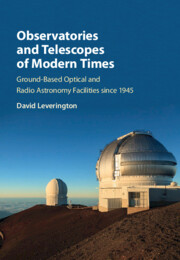 Observatories and Telescopes of Modern Times
Observatories and Telescopes of Modern Times from Part 1 - Optical Observatories
Published online by Cambridge University Press: 15 December 2016
Mount Stromlo, the Early Years
Unlike many optical observatories discussed in this book the foundation of the Mount Stromlo observatory in Australia goes back to before the Second World War. In fact the idea of building a solar observatory in Australia goes back to before the First World War when Walter Duffield, an Australian working at the University of Manchester in the UK, pointed out its potential advantages. Not only would it fill the coverage gap in observing the Sun from the western Pacific, but it would also offer excellent observing conditions during the northern winter when the northern solar observatories were often compromised by poor weather and limited daylight.
In 1909 James Oddie, a wealthy philanthropist, donated a 9 inch (22 cm) Grubb refractor to the Commonwealth government of Australia to be the basis of a new national observatory, and the trustees of Lord Farnham's estate donated a 6 inch (15 cm) refractor to the observatory ‘if and when it was founded’.(1) A board was then appointed by the government to find a suitable site near Canberra, the capital of the new Commonwealth of Australia. Two years later the board chose Mount Stromlo, at an altitude of 2,530 ft (770 m), where the 9 inch was installed to undertake site testing. But the First World War was to intervene before a firm decision could be taken to build the observatory. In the event, building of the Commonwealth Solar Observatory was finally begun at Mount Stromlo in the mid 1920s.
Although the main work of the observatory was observing the Sun, it also undertook other astronomical observations. For example, in 1924 John Reynolds, a British engineer and amateur astronomer donated a 30 inch (75 cm) reflecting telescope with equatorial mounting for photographing nebulae of the southern sky, and William Rimmer used the Oddie refractor to measure the parallaxes of the brighter stars. But the most important work of this early period was undertaken by Clabon Allen who used a newly completed vertical solar telescope with an 18 inch (45 cm) coelostat and 12 inch (30 cm) objective to produce a comprehensive photometric atlas of the solar spectrum.
To save this book to your Kindle, first ensure [email protected] is added to your Approved Personal Document E-mail List under your Personal Document Settings on the Manage Your Content and Devices page of your Amazon account. Then enter the ‘name’ part of your Kindle email address below. Find out more about saving to your Kindle.
Note you can select to save to either the @free.kindle.com or @kindle.com variations. ‘@free.kindle.com’ emails are free but can only be saved to your device when it is connected to wi-fi. ‘@kindle.com’ emails can be delivered even when you are not connected to wi-fi, but note that service fees apply.
Find out more about the Kindle Personal Document Service.
To save content items to your account, please confirm that you agree to abide by our usage policies. If this is the first time you use this feature, you will be asked to authorise Cambridge Core to connect with your account. Find out more about saving content to Dropbox.
To save content items to your account, please confirm that you agree to abide by our usage policies. If this is the first time you use this feature, you will be asked to authorise Cambridge Core to connect with your account. Find out more about saving content to Google Drive.